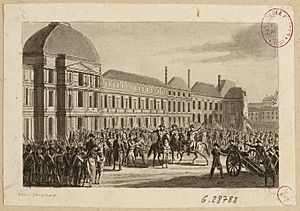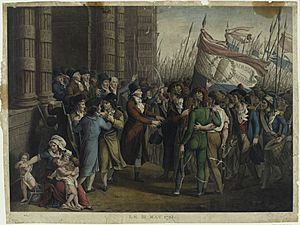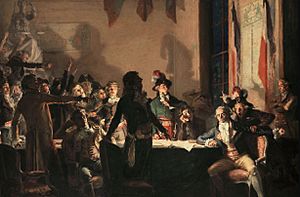François Hanriot facts for kids
François Hanriot (born December 2, 1759 – died July 28, 1794) was an important French leader during the French Revolution. He was a prominent figure among the Sans-culottes, who were ordinary working people in Paris. Hanriot also became the commander of the National Guard, a citizen army, in Paris.
He played a key role in the events of May 31 to June 2, 1793, which led to the removal of the Girondins, a political group, from power. On July 27, 1794, he tried to help Maximilien Robespierre, who had been arrested. Hanriot was executed the very next day, along with Robespierre and others.
Contents
Early Life and Work
François Hanriot was born in Nanterre, a town near Paris. His parents worked as gardeners for a former French Treasurer.
Hanriot did not have one specific job for long. He first worked for a lawyer, doing secretarial tasks, but he lost this job. Later, in 1789, he became a clerk in Paris, dealing with taxes. He was dismissed from this job too, after leaving his post during a time of public anger when a popular official was fired. Hanriot was arrested and held in Bicêtre prison, but he was released the next year.
After these difficulties, Hanriot was unemployed and very poor for a while. He then had various jobs, possibly as a shopkeeper or a peddler. He lived in a neighborhood near the Jardin des Plantes in Paris.
Hanriot's Role in the Revolution
As the Revolution progressed, Hanriot became well-known for his strong views against the wealthy and powerful. In January 1792, he started speaking out against leaders like Lafayette. He became a speaker for his local sans-culottes section, which was a large and less wealthy area of Paris.
On August 9, 1792, when the Assembly refused to take action against Lafayette, church bells rang to call people to arms. The next day, the Tuileries Palace was stormed by the National Guard and ordinary citizens.
Hanriot was a member of the Cordeliers club, a political group. He strongly supported taxing the rich, saying they should be presented "with a bill in one hand and a pistol in the other." Because of his strong opinions, he gained many followers among the local sans-culottes. On September 2, they made him a captain in the National Guard battalion for his area.
The Fall of the Girondins
In the spring of 1793, there was a lot of political tension in Paris. Radical groups like the Commune and the Montagnards in the Convention became very hostile towards the ruling Girondins. When the authorities arrested Jean-Paul Marat in April, things got even worse. This led to the fall of the Girondins, and Hanriot played a big part in it.
On the evening of May 30, 1793, the Commune temporarily appointed Hanriot as the "Commandant-General" of the Parisian National Guard. He was ordered to march his troops to the National Palace. The goal was to force the Convention to get rid of a special committee and arrest 22 specific Girondin leaders.
During the night of May 30-31, the city gates were closed. At 3 AM, the alarm bells rang. Hanriot ordered a cannon to be fired as a signal, even without the Convention's permission. Some Girondin leaders suggested arresting Hanriot.
On the evening of June 1, the revolutionary committee ordered the arrest of 27 Girondins and other officials. They also banned Girondin newspapers. Hanriot was ordered to surround the Convention with a large armed force. The Convention decided to pay men for carrying arms during this crisis.
On Saturday, June 1, the Commune spent almost the whole day preparing for a "great movement." By evening, 40,000 men surrounded the Convention building to force the arrests. Hanriot first took control of important locations like the Arsenal and the Pont Neuf. The city barriers were closed, and suspects were arrested.
The next morning, June 2, Hanriot told the Convention that all his men were ready and in position. He ordered the National Guard to march from the town hall to the National Palace. By early evening, a large force of armed citizens, estimated at 30,000 to 80,000, surrounded the Convention with 63 cannons. Hanriot declared that the armed force would not leave until the Convention handed over the deputies that the Commune had named.
The accused Girondins tried to leave the palace but were met by soldiers with bayonets and pikes. They returned to the meeting hall and had to accept their fate. Twenty-two Girondin deputies were arrested.
On June 2, 1793, women gathered in front of the Convention. Hanriot's troops surrounded the building with thousands of armed volunteers, cannons, and pikes. Soldiers entered the building and disrupted the meetings. The President of the Convention, Herault de Sechelles, asked Hanriot to remove his troops, but he refused. Under this pressure, the Convention voted to arrest 22 Girondin deputies, removing them from power.
After this, Hanriot was seen as a hero by some. On June 11, Hanriot resigned his command, saying that order had been restored. However, he was re-elected by his section on June 29. On July 1, he was elected by the Commune and two days later became the permanent commander of Paris's armed forces.
On September 4, the sans-culottes again entered the Convention. With Hanriot's support, they demanded stronger actions against rising prices and the use of terror to stop counter-revolutionaries. On September 19, the Convention supported his appointment as general of the Parisian National Guard. Hanriot moved into an apartment in the Hôtel de Ville, Paris, the city hall.
The End of the Reign of Terror
In the spring of 1794, tensions grew between Robespierre and the Committees on one side, and the Paris Commune and the sans-culottes on the other. On March 6, Hanriot appeared before the Convention with 1,200 men. This led to the arrest of Hebert and his allies on March 13. Hanriot, who supported some of Hébert's ideas, was protected by Robespierre. On March 27, the sans-culotte Revolutionary Army was disbanded, and its artillery units were placed under Hanriot's command. Even though he agreed with some of Hébert's radical ideas, Hanriot remained loyal to Robespierre.
On July 27, 1794, a group of Convention members planned to overthrow Robespierre and his allies. This event is known as the Thermidorian Reaction. They decided that Hanriot and his close associates should be arrested first, to leave Robespierre without support.
Around 3 p.m., Hanriot was ordered to appear before the Convention. He gathered 2,400 National Guards in front of the town hall, warning them that there was an attempt to harm Robespierre.
When the Paris Commune heard about the arrests, it began gathering forces to free Robespierre and his allies and take control of the Convention. The mayor ordered Paris prisons to refuse any prisoners sent by the Convention. Hanriot took charge of preparing the military to close down the Convention.
When Hanriot appeared at the Place du Carrousel in front of the Convention, he was taken prisoner by an older deputy. The Convention then declared Robespierre, Hanriot, and their supporters to be outlaws. When the Paris militants heard this news, their order broke down, and they became divided.
In the evening, Robespierre, Hanriot, and other freed prisoners gathered at the Hotel de Ville, which became their headquarters. The Convention responded by declaring them outlaws, meaning they could be captured dead or alive. They ordered their own troops, led by Barras, to stop them. Hanriot ordered the entire square to be lit with torches. Within an hour, the Commune's forces quietly left the square. Around 2 AM, the Convention's troops arrived. Robespierre and others were arrested.
Hanriot fell from a window and was found later, unconscious, in a nearby courtyard. He was taken to the guillotine in the same cart as Robespierre and his brother. Hanriot was executed just before Robespierre on July 28, 1794. He was barely conscious when he was led to the platform.
Some accounts say Hanriot tried to escape through a hidden staircase. Others say he was thrown out of a window by one of his own allies after being blamed for the disaster. Regardless, Hanriot landed in a small courtyard. He managed to crawl into a drain, where he was found twelve hours later and taken to prison.
On July 28, the Revolutionary Tribunal condemned Robespierre and 21 others to death. They were taken in three carts to the Place de la Révolution to be executed.
Images for kids
See also
 In Spanish: François Hanriot para niños
In Spanish: François Hanriot para niños





